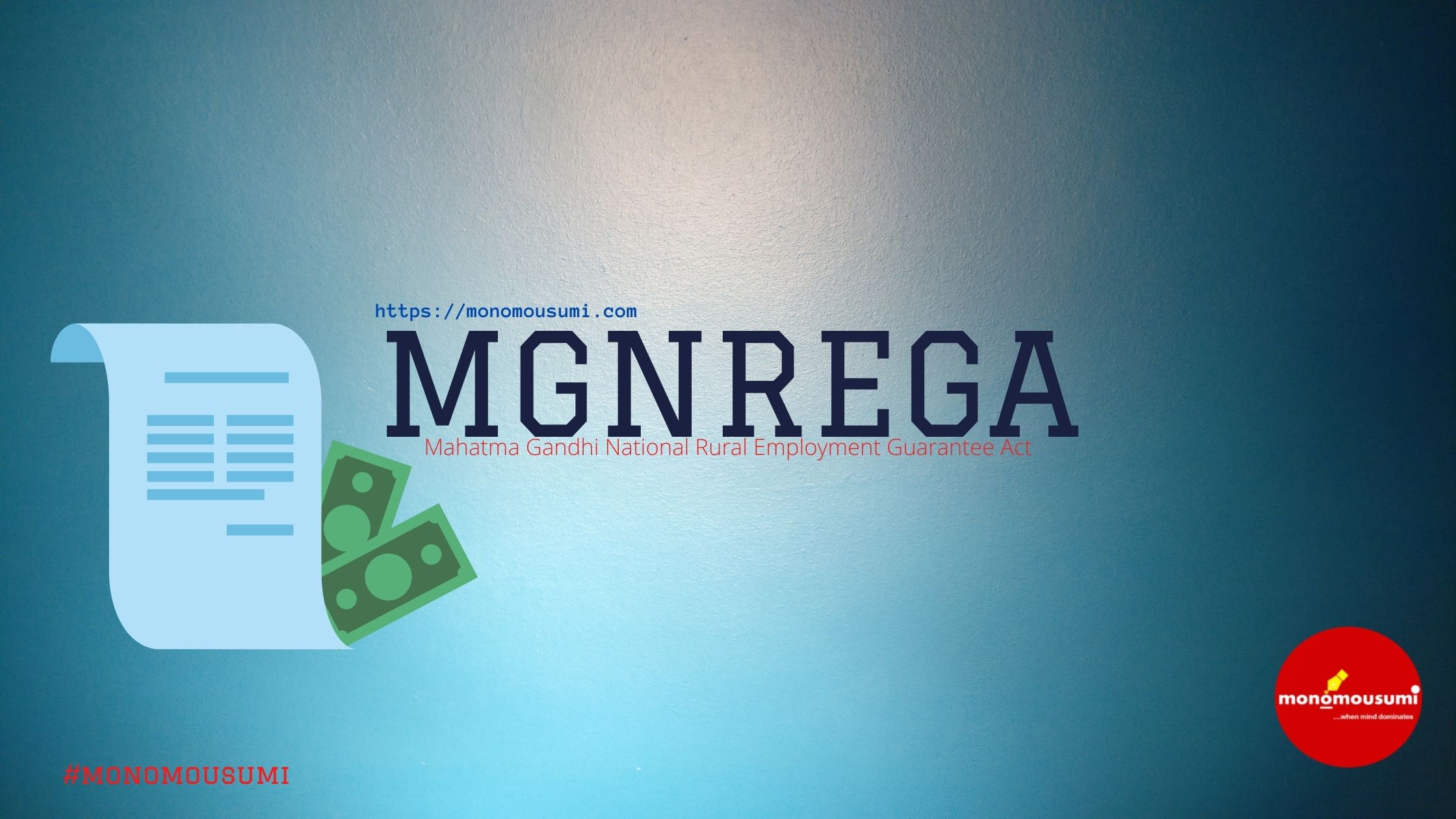
MNREGA 2005 was a significant piece of enactment which reaffirmed India’s situation similar to a government assistance state. The Act ensured at any rate 100 days of paid work in provincial regions in a year. At the time it was broadly hailed as unquestionably tying down social equity to a very part of society, which had up to that point remained to a great extent overlooked and sidelined.
Be that as it may, the execution instrument of this Act has gone under extreme analysis with broad claims of misrepresentation and debasement at all degrees of usage component. This paper endeavors to take a gander at the first weighty arrangements, the issues that followed and afterward proceeds to recommend a few arrangements.
Mahatma Gandhi National Rural Employment Guarantee Act (MGNREGA) is a task ensure plot for provincial Indians. It was established by enactment on 25 August 2005. The plan gives a lawful assurance to in any event 100 days of paid work in each monetary year to grown-up individuals from any family unit willing to accomplish untalented manual business related to public work at the legal the lowest pay permitted by law of 120 (US$1.80) each day in 2009 costs. In the event that they neglect to do so the public authority needs to pay the compensation at their homes. The focal government expense for the plan was 4000 billion (US$61 billion) in the monetary year 2010–11.
This demonstration was presented with the point of improving the buying force of semi-or un-gifted rustic individuals of India, independent of whether they fell underneath the neediness line. Around 33% of the specified work power is ladies. The law was at first called the National Rural Employment Guarantee Act (NREGA) and was renamed with the prefix “Mahatma Gandhi” on 2 October 2009, Gandhi’s introduction to the world commemoration.
In the time of 2011, the program was regularly reprimanded as not any more viable than other difficulty decline programs in the nation of India. Notwithstanding its best targets, well known MGNREGA is assailed with banter about harmed specialists, need subsidizing as the wellspring of assets, bad quality of offices planned under this program, and irregular risky effect on difficulty.
BACKGROUND AND COVERAGE OF MGNREGA
The Mahatma Gandhi National Rural Employment Guarantee Act is a lead Program of Government of India. The Act was advised at first in 200 most in reverse locale of the nation w.e.f. February 02, 2006 and therefore expanded all over India in two stages:- it was stretched out to extra 130 regions included the monetary year 2007-2008 (113 locale were informed with impact from April first, 2007, and 17 areas in Uttar Pradesh (UP) were told with impact from May fifteenth, 2007).
The excess locale have been advised under MGNREGA with impact from April 1, 2008. In this manner, the MGNREGA covers the whole country except for locale that have a hundred percent metropolitan populace. The program targets upgrading job security of the provincial poor by giving at any rate 100 days of ensured wage work in a monetary year to each family unit whose adult people volunteer to achieve awkward manual work.
The Act tries to make strong resources and reinforce the business asset base of the provincial poor. The selection of works proposed in the Act address reasons for ongoing destitution like dry season, deforestation, soil disintegration so the interaction of business age is on a supportable premise.
MEANING OF THE ACT
The MGNREGA has offered climb to the greatest work program in humankind’s arrangement of encounters and isn’t typical for some other compensation business program in its scale, designing, and push. It’s base up, people centered, demand driven, self-picking, rights-based arrangement is specific and remarkable. The MGNREGA gives a legal confirmation to wage business. It is an interest driven program where the game plan of work is set off by the interest for work by wage-searchers.
There are genuine game plans for settlements and pay both in occurrences of powerlessness to give work on interest and deferments in portion of wages for work endeavored. The MGNREGA routs issues of zeroing in through its self-zeroing in on segment of beneficiary assurance, that is, an immense degree of least blessed of destitute individuals and limited search for work under the Scheme. The Act helps States to give business, as 100% of the uncouth work cost and 75% of the material cost of the program is borne by the Center.
Not in any manner like the past pay work programs that were task based, MGNREGA is demand driven and resource move from Center to States relies upon the interest for work in each State. This gives an additional persuading power to States to utilize the Act to meet the work needs of needy individuals. There is furthermore a going to disincentive for fail to give work on time, as the States by then bear the cost of the joblessness settlement. Gram Panchayats (GPs) are to realize in any occasion half of the works with respect to cost.
This solicitation for devolution of money related resources for GPs is exceptional. Plans and decisions as for the nature and choice of endeavors to be embraced, the solicitation in which each work is to be set off, site assurance, etc are all to be made in open social events of the Gram Sabha(GS) and affirmed by the GP. Works that are implanted at Intermediate Panchayat(IP) and District Panchayat(DP) level should be attested and alloted a need by the GS before definitive support can be given. The GS may recognize, modify or reject them.
These decisions can’t be brought down by higher trained professionals, however to the level of ensuring congruity with the game plans of the Act and its Operational Guidelines. This base up, people centered, demand driven designing similarly infers that a phenomenal bit of the commitment with respect to the achievement of the MGNREGA lies with wage-searchers, GSs and GPs. MGNREGA also signifies a break from the mitigation activities of the past towards a planned trademark resource the heads and jobs age perspective.
Social survey is another segment that is a fundamental piece of MGNREGA. Conceivably, this makes exceptional obligation of execution, especially towards brief accomplices. An Annual Report masterminded by the Central Employment Guarantee Council (CEGC), on the aftereffects of MGNREGA is should have been presented each year by the Central Government to Parliament.
Essentially, the yearly reports masterminded by State Employment Guarantee Councils (SEGC) are to be acquainted with State Legislatures by the State Governments, empowering oversight by picked delegates. The essentially new character of the program, requires inventive approach for convincing use. This will ensure that the novel parts of the MGNREGA are recognized fittingly on the ground; at the bleeding edge level of its use. These Operational Guidelines have been given to energize this consistence.
GOALS OF THE ACT
Every Act has a few objectives and plans to be accomplished. The Mahatma Gandhi National Rural Employment Guarantee Act was likewise authorized with some point and objectives. These objectives are:
• To give social assurance to the most weak individuals living in rustic India by giving business freedoms to them.
• To give Livelihood security to the poor through the formation of tough resources, improved water security, soil protection, and higher land efficiency.
• To have proficient Drought-sealing and flood the board in provincial India.
• Empowerment of the socially impeded individuals, particularly ladies, Scheduled Castes (SCs) and Schedules Tribes (STs), through the cycles of rights-based enactment.
• Strengthening decentralized, participatory arranging through the union of different enemy of neediness and occupations activities.
• Deepening vote based system at the grass-roots by fortifying Panchayati Raj Institutions.
• Effecting more prominent straightforwardness and responsibility in administration.
In this way, MGNREGA is an incredible instrument for guaranteeing comprehensive development in provincial India through its effect on social insurance, occupation security, and majority rule strengthening.
SALIENT FEATURES OF THE ACT
The notable highlights of the Act are:
- All grown-up individuals from a rustic family willing to accomplish untalented manual work reserve the privilege to request business.
- Such a family should apply enlistment to the Gram Panchayat.
- After confirmation, the Gram Panchayat will give a Job Card with photo of all grown-up individuals from the family willing to work under the program.
- The Job Card should stay in the care of the family unit.
- Job Cardholder can apply for work to the Gram Panchayat which will give him/her a dated receipt of the work application.
- Employment will be given by the Gram Panchayat (neighborhood self-overseeing body) inside 15 days of work application, bombing which joblessness stipend will be paid.
- Disbursement of wages must be done week by week premise and not past a fortnight.
- Wages will be paid at the compensation rate to the workers through their Bank/Post office accounts.
- An yearly rack of attempts to be set up ahead of time for every year.
- A ratio of 60:40 for wage and material costs should be maintained at the GP level.
- No contractors/and no labor-displacing machinery shall be used in the execution of works.
- Panchayati Raj Institutions will have a chief job in arranging, observing, and execution.
- At least 33% of the specialists ought to be ladies.
- Inbuilt impetus disincentive construction to the State Government for ensuring work.
SOME OTHER PROVISIONS OF THE ACT
Funding:
• Central Government – 100% of wages for incompetent manual work, 75% of the material expense of the plans including installment of wages to talented and semi-gifted laborers.
• State Government-25% of material including installment of wages to talented and semi gifted laborers cost. 100% of the joblessness remittance by the state government.
Timely Allocation of Work:
• Schedule I, Para 10 of Mahatma Gandhi NREGA states that it will be accessible to the PO and the GP to arrange any person who has gone after work to oversee position of any kind sensible under the Act.
• The data on work mentioned and work apportioned is needed to be referenced in the JC and Employment Register too. In this way, it is essential that it ought to be recorded hands on Card and the Employment Register
• The State Government will depict clear coordination components so information on work mentioned and apportioned by the Program Officer and the Gram Panchayat are appropriately kept up. Gram Panchayat and Block Officers ought to likewise share data on work allotted and works opened.
Unemployment Allowance:
1.If a candidate isn’t given work inside fifteen days of receipt of his/her application looking for work, he/she will be qualified for an every day joblessness recompense. On account of advance applications, business ought to be given from the date that work has been looked for, or inside 15 days of the date of application, whichever is later. Else, the joblessness remittance gets due.
2.The joblessness remittance will be paid according to Section 7 of the Act. The stipend won’t be short of what one-fourth of the compensation rate for the initial thirty days and at least one-portion of the compensation rate for the leftover time of the monetary year.
3.State Govt. will:
a.) Under area 7 (2) of Act, determine the pace of joblessness stipend payable and
b.) Frame Rules administering the technique for installment of joblessness stipend.
c.) Make fundamental budgetary arrangement for installment of joblessness stipend
4.The technique to be recommended by the State Govt. ought to be kept extremely basic. The methodology may include:
a.) Automatic age of an installment request (requiring no different endorse request) and installment of joblessness remittance from the SEGF or some other asset indicated for this reason based on information in NREGA delicate.
b.) Payment to be made no later than 15 days from when it becomes due or probably the beneficiaries will be qualified for remuneration dependent on similar standards as pay under the Payment of Wages Act, 1936.
c.) Unemployment stipends to be credited to Bank/PO account as in the instance of compensation installments and so forth .
5.In agreement with arrangements in Section 8(2) of MGNREGA,every instance of non-installment or postponed installment of joblessness recompense will be accounted for in the Annual Report put together by the DPC to the State Government alongside the explanations behind such non- installment or postponed installment.
6.Section 8(3) of MGNREGA states that the State Government will take all measures to make the installment of joblessness recompense to the concerned family unit as speedily as could really be expected.
7.The obligation of the State Government to pay joblessness recompense to a family unit during any monetary year will stop as before long as:
a.) The candidate is coordinated by the GP or the PO to report for work
either without help from anyone else or depute in any event one grown-up individual from his family, or
b.) The time frame for which business is looked for reaches a conclusion and no individual from the family unit of the candidate had turned up for business; or
c.) The grown-up individuals from the family unit of the candidate have gotten altogether in any event 100 days of work inside the monetary year; or on the other hand
d.) The family unit of the candidate has acquired as much from the wages also, joblessness remittance taken together which is equivalent to the compensation for 100 days of work during the monetary year.
8.An candidate who:
a.) Does not acknowledge the work gave to his/her family unit; or
b.) Does not report for work inside fifteen days of being advised by the Program Officer or the executing office to report for the work; or
c.) Continuously stays missing from work, without getting a grant from the concerned actualizing organization for a time of more than multi week or stays missing for a complete time of mutiple week at whatever month.
It will not be qualified to guarantee the joblessness recompense payable under this Act for a time of a quarter of a year however will be qualified to look for work under the Scheme whenever.
Wage related:
• Section 6(1) of MGNREGA states that despite anything contained in the Minimum Wages Act 1948, the focal Government may by notice determine the pay rate for the motivations behind the Act:
Provided that various paces of wages might be determined for various regions:
Provided further that the pay rate indicated now and again under any such notice will not be at a rate under sixty rupees each day.
• Section 6 (2) expresses that until such time as a compensation rate is fixed by the focal Government in regard of any region in a State, the lowest pay permitted by law fixed by the State Government under Section 3 of the Minimum Wages Act, 1948 for farming workers will be considered as the pay rate pertinent to that region.
• In exercise of forces under Section 6(1) of the Act, Ministry of Rural Development informed compensation rate on 01.01.2009 receiving the lowest pay permitted by law rate for horticultural work of the States as on 1.12.2008.
In similarity to the presentation by Hon’ble Finance Minister in his spending talk 2009 to give a veritable pay of Rs. 100/ – a day as an advantage under the Mahatma Gandhi National Rural Employment Guarantee Act, on the requesting of this Ministry, the Ministry of Statistics and Program Implementation included a board under the Chairmanship of Dr. Pronab Sen, Principal Adviser, Planning Commission to develop a framework to build up a design to make an alternate document for reviving of MGNREGA remuneration. The Committee has delegates from Ministry of Rural Development as Members close by depiction from various Ministries and Departments. The report of the Committee is envisioned.
It has been reasoned that till such time that an adequate document is proposed by Dr. Sen Committee and recognized by the Government, the Government could document the wages with the Consumer Price Index for Agriculture laborers (CPIAL). In similarity of this, the Ministry gave an admonition dated fourteenth January 2011 refreshing pay rates under Section 6(1) of the MGNREG Act with indexation to CPIAL.
The rethought wage rates were made relevant w.e.f 01.01.2011. The remuneration rates have been also changed in 2012 vide notice dated 23.3.2012 practical from first April 2012. For appearing at the latest rethought rates, the rate increase in the CPIAL for November 2010 to December 2011 has been applied to MGNREGA wage rate as on first January; 2012. It has in like manner been picked to extend the compensation rate each year. The nuances of changed wages educated for States are given in Annexure-XIII.
Summing up-
The National Rural Employment Guarantee Act (MGNREGA) 2005 is achievement authorization in Indian history of government oversaw retirement sanctioning after self-rule. Endorsed after a productive fight for work guarantee sanctioning, it is an inadequate victory towards a full‐fledged option to work in any farming country setting. The crucial segment of this institution what segregates it from some other public assistance provisioning plan is its request through the parliament of India.
This institution has been accomplishing a tranquil distress in commonplace regions of the country. MGNREGA Act out of the blue brings the work of the state as a provider of occupation inside the extent of the individuals/beneficiaries themselves. By plan, it isn’t exactly equivalent to any work age scheme that has been as of late executed. It requires different technique towards business age plans and towards as a rule commitment of the State in giving the advantage to work to its masses .
By Adv.Chhaya Shamkumar Mehare, Taluka-Murtizapur


